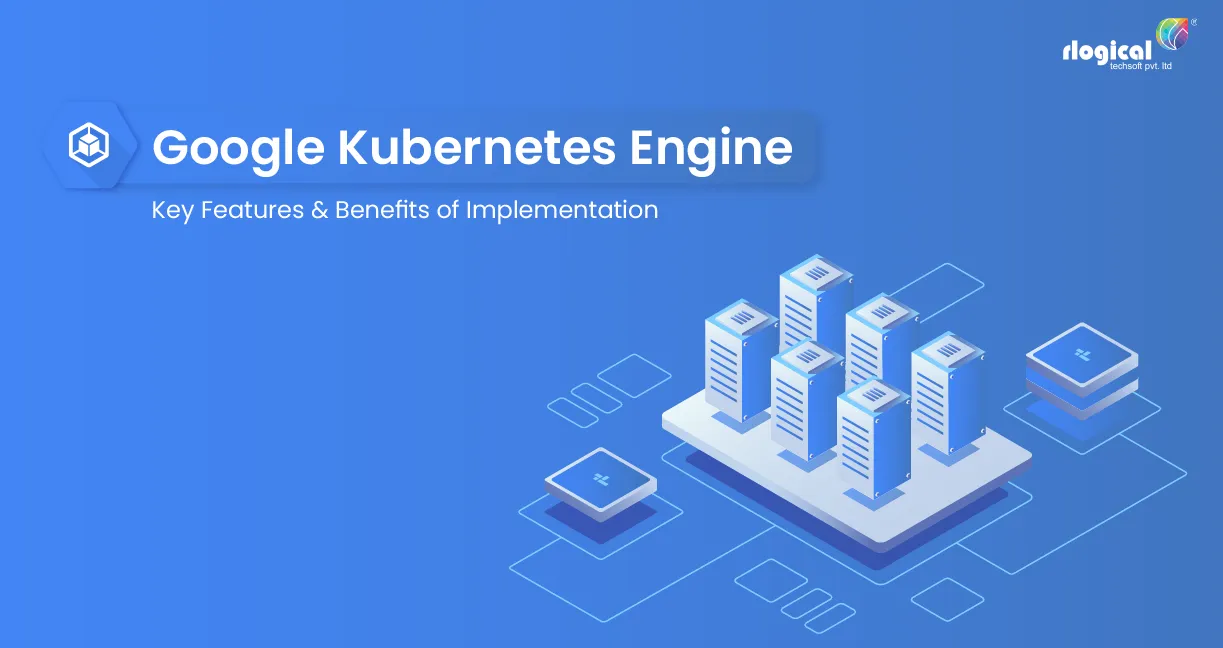
In the modern technology world, the ways of computing tasks have evolved a lot. Now the technical domain is inclining towards cloud computing as it solves various problems such as accessibility and scalability. Most of the time, people use the same resources for running multiple software or programs on various operating systems, which creates inconsistencies. But this issue is eradicated with Google Kubernetes Engine or GKE as it includes containers that make programs not dependent on OS. It can speed up the app development services using solutions created with the cloud ecosystem.
It is the simplest way to deploy, scale, and manage apps through Google infrastructure. In this blog, you will understand Kubernetes in detail, GKE’s salient features, and the advantages you can get by implementing it.
Kubernetes Overview
It is an extensible and portable open-source platform used to manage containers. It was created by Google, also known as K8s, which makes many computers or machines work in one unit. Through Kubernetes, several people can utilize containerized apps that work together, whether the apps are on various platforms.
Why To Opt For GKE (Google Kubernetes Engine)?
GKE helps a lot in app development services as it manages containerized applications. There are many reasons to select GKE, and some of them are mentioned below.
- Google developed both GKE and Kubernetes. So, there is an excellent team, and GKE provides easy integration with plentiful Google services.
- It offers nodes auto-scaling that Amazon Kubernetes and Azure container Services lack.
- Any new tool or feature released will be seen first in GKE before it comes to other vendors.
- GKE is the cheapest Kubernetes service which makes an amazing option to choose when working with containers.
Must Read: AWS vs. Azure vs. Google Cloud
Key Advantages of Google Kubernetes Engine
1. Accelerate App Development Without Compromising Security
The app development services automatically become faster with continuous integration and continuous deployment tools. The use of Kubernetes-native CI/CD tools helps secure and accelerate every stage of the create-and-deploy life cycle.
2. Release Channels for Streamlining Operations
With GKE, you can select a release channel that best suits your business requirements. It provides faster and stable channels having the option of node upgrades. Moreover, you can get the support levels lined up with channel nature.
3. Google Site Reliability Engineers for Monitoring Clusters
With Google SREs, you can look at your cluster, storage resources, and computing networks. It has built-in integrations for troubleshooting incidents quickly.
4. Access Several Storage Options
There are many storage options in GKE that you can use in app development services. The options differ in ease of utilization and flexibility. GKE has storage abstractions used for providing storage to clusters.
5. Use of Load Balancing
GKE enables users to define the way the apps are deployed or communicate with one another. The networking model depends on IP address. Services, containers, nodes, and pods communicate through IP addresses. Thus, it offers multiple load balancing types to direct the traffic towards the right pods.
Major Features of Google Kubernetes Engine
1. Different Operation Modes
GKE provides two operation modes that are Autopilot and Standard. Autopilot is a solution that handles the infrastructure of the whole cluster without the need for configuration and monitoring. It includes per-pod billing, where you only have to pay for the running pods and not for the system components, unallocated space, or overhead of operating systems. The Standard mode provides you complete control over nodes and the capability to adjust and run administrative workloads.
2. Auto-Scaling of Cluster and Pod
GKE is the fully managed service of Kubernetes that comprises Kubernetes API, release channels, multi-cluster support, and 4-way auto-scaling. The auto-scaling of the horizontal pod is based on custom metrics and CPU usage. Cluster auto-scaling runs on a per-node-pool basis, and the auto-scaling of vertical pod analyzes memory and CPU usage. It automatically adjusts the memory and CPU requests.
3. Prebuilt Apps and Templates
In GKE, you can get containerized solutions along with prebuilt templates, consolidated billing, featuring portability, and simplified licensing. Such solutions are not container images. These are commercial open-source apps that elevate developers’ productivity.
4. Ease of Migration
GKE and Anthos make migration from traditional workloads easier, and they help get to the native containers. The automated approach takes out the important app elements from virtual machines. Therefore, you can insert the elements inside the container in GKE without virtual machine layers. It also works with Autopilot mode.
5. Better Security and Networking
GKE sandbox offers an additional defense layer between workloads for improving the security of containerized workloads. GKE clusters support the Network Policy of Kubernetes for restricting traffic through pod firewall rules. GKE private clusters restrict to the private or public endpoint, accessible to only a few address ranges.
Must Read: Important ASP.NET Core Features – Need to Know
Additional Features of GKE
- Hybrid Networking
It reserves IP addresses for your cluster and allows the cluster IP addresses to coexist through the Cloud VPN of Google.
- Cluster Options
The clusters can be customized to the version stability, pod traffic, availability, and isolation needs of the workloads.
- Auto Repair
If a node has a health check failure, GKE begins that node’s repair process.
- Auto Upgrade
It automatically keeps the cluster up-to-date with every latest Kubernetes version release.
Conclusion
Google Kubernetes Engine is excellent for automatic management and monitoring of application containers. It offers an environment where different machines can work together and make application development much easier. With a large number of features and amazing benefits, GKE is the best option to go for.
Rahul Panchal
Rahul Panchal is the Founder & Managing Director at Rlogical Techsoft Pvt. Ltd. He is a pioneer tech enthusiast who has assisted diverse enterprise solutions with a fresh perspective over the years. From integrating technologies like Full-Stack, .NET, Flutter & PHP, he has harnessed custom web or hybrid mobile app development projects. His creative outlook on the latest models of AI, ML, blockchain, and IoT, has made various businesses attain leading-edge success.
Related Blog
- Progressive Web App Development Cost: Accurate Figures Guide
- Top Hybrid App Development Frameworks to Capture 2025 Trends For Your Business
- How Much Does MVP Cost: Factors Influence MVP Development Budget & its Reduction Tips
- Progressive Web App Benefits for Your Business Growth in Future Market
- Flutter for Web App Development: The Cross-Platform Companion For Your Business
Categories
- All
- AI Development Services
- Amazon Web Services (AWS)
- ASP.Net Development
- Azure Web App
- Big Data Analytic
- Customize
- Digital Marketing
- Drupal Development
- E-commerce web development
- Education Mobile App Development
- Enterprise Application
- Event Management App Development
- Fintech
- Fitness App Development
- Food Delievery
- Front-End Development
- Healthcare App Development
- Hire Dedicated Developers
- Hotel Booking App
- IT Industry
- JavaScript Development
- Mobile App Development
- On Demand App Development
- On Demand Healthcare App Development
- PHP Development
- POS Software Development
- Real Estate Mobile App Development
- Retail Business App Development
- Salesforce
- Social Media Development
- Software Development
- Technology
- Transportation App Development
- UI/UX Design
- Web Design
- Web Development
- Web Services
- Web/Data Scraping Services
- WordPress




 Rahul Panchal in Mobile App Development
Rahul Panchal in Mobile App Development 





